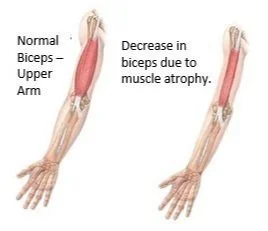Upside Down Polio
Living with Upper Extremity Weakness.
Polio survivors with the majority of their muscle weakness in their upper body have sometimes been called “upside down polios”. This term is based on the fact that the majority of observable weakness and atrophy in most polio survivors is in the lower part of their bodies. Therefore, if a person has the reverse, with most of their weakness/atrophy in their shoulders, arms, and/or hand, it is “upside down” from what is usually observed.
The muscle atrophy in the upper extremity may not be as obvious to the casual observer as it is in people with atrophy/weakness of their legs with an obvious limp, because the atrophy can often be hidden under clothing (ex: keeping a polio affected hand in a pocket most of the time). Upper body weakness, may take close observation in order to notice that these polio survivors perform daily tasks differently, such as using two hands to lift a glass up to their mouth or use some different movements to put on or take off a coat or sweater.
If the weakness involves a person’s right hand, they may choose to “shake hands” using their left hand or use other movements (nodding their head, a slight wave) to convey a greeting. Polio survivors with marked weakness of both arms may need someone to feed them, dress them, and perform many activities of daily living. Some who had polio at a young age may have learned to use their feet to do many of the tasks that others normally do with their hands/arms such as writing, peeling vegetables, and even doing art work; others do tasks using their mouth such as using a mouth stick to type, write and paint.
Individuals with upper extremity weakness are more likely than those with lower extremity weakness to have some respiratory muscle weakness because some of the same nerves that control the arms also control the diaphragm.
Persons who have had significant lower extremity weakness and have used their arms to assist with many activities that require leg strength (ex: getting up and down from a chair or walking with crutches) are quite likely to develop overuse problems in their shoulders, elbows, and/or wrists. Upper extremities were not designed to be used for long-term walking! This may be temporary after a particular period of overuse or can become chronic. It can be a tendonitis, a bursitis, wear-and-tear arthritis, or a tear of various tendons/muscles such as rotator cuff tears or biceps muscle rupture, etc. All of these can initially result in pain which then can lead to weakness because if it hurts to perform certain motions, people stop doing that motion or severely limit the use of muscles that effect that motion.
Bottom line: Even if a person’s initial polio primarily affected their legs, it is likely that over time they are at risk of developing some overuse symptoms in their upper body that can limit their use of their upper extremities.
Over the past few years, I began to have pain in my shoulders (right greater than left) that limits my ability to perform certain activities such as putting on or taking off certain clothing like sweatshirts, jackets, and blouses/shirts. After watching some polio survivors with upper body weakness, I learned that I could still do those activities with little or no pain. I just had to change the way I was doing things and use the techniques that those “upside down polios” used. So, now instead of removing a sweatshirt by crossing my arms in front of my body and grasping the lower left hem with my right hand and the lower right hem with my left hand and then pulling straight up and over my head, I now lean forward (getting my trunk nearly horizontal), grasp the back of the neck opening with one hand and pull slightly up and horizontally until the sweatshirt is over my head and off. (Note: graphic is for a jacket but the idea is similar).
Paulette Bergounous, a polio survivor with little functional use of one hand/arm, has reported that many of the people accessing her blog and videos are previously able bodied people that now are scheduled for shoulder surgery that will require little or no use of one arm for several weeks to months. A good occupational therapist can assist you with methods that work for your particular limitations.
This graphic is a good series of illustrations that shows pulling a shirt over ones head
with the use of a single arm.
This graphic is a good series of illustrations showing putting on long pants with the use of a single arm.
As in many aspects of aging, there are many useful tricks and techniques that we can learn from other polio survivors. We can adapt and use what we need as we develop some of the limitations of a long life.
There’s nothing “upside down” about the two polio survivors living with upper body paralysis, whose stories we’ve had the opportunity to publish. Martha Loudder and Deborah Stambaugh are determined, resilient and very much upright.
Their stories are easily available on the Survivor Stories page of our website.





